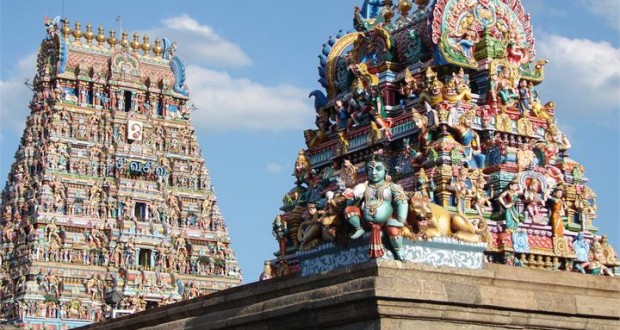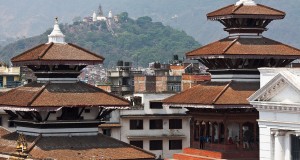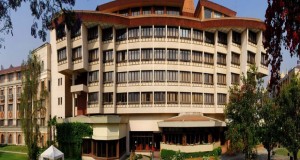Fort St George-St Mary’s Church-Government Museum-National Art Gallery-Valluva Kottam-Guindy Snake Park-Kapaleeshwara Temple-San Thome Basilica
From the tourist office, it’s a straight run up Anna Salai to the birthplace of Madras, 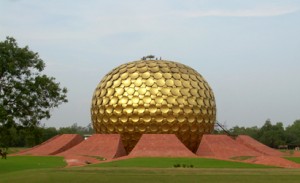 Fort St George. Rebuilt several times between 1642 when its original bastions were completed, and 1749 when the French left, it remains—moats and all—pretty much today as when first made the seat of empire. Declared a national monument in 1948, most of its buildings have been converted into government offices, notably the Legislature and Secretariat. At various times the fort was home of Robert Clive, Elihu Yale and Sir Arthur Wellesley (later Wellington). Within the fort, visit the sturdy little St Mary’s Church (open daily, 8.30 am-5.30 pm), the oldest Protestant church east of Suez and the first Anglican one in India. Built in 1680 from voluntary contributions of the Fort’s English inhabitants, it gained its spire in 1710, and was completely renovated in 1759. Designed by a British gunner, and built to last with walls 1.2 m (4 ft) thick and a roof 0.6 m (2 ft) thick, this church is noteworthy for its total stone composition: no wood is used anywhere.The three aisles, arched with brick and stone, have a bomb-proof vaulted roof. The gallery has a finely carved nave, with two curved outer staircases. In the courtyard, you’ll see some of the oldest British tombstones in India; some have been moved inside and are now beneath the altar.The Renaissance painting above the altar was painted by
Fort St George. Rebuilt several times between 1642 when its original bastions were completed, and 1749 when the French left, it remains—moats and all—pretty much today as when first made the seat of empire. Declared a national monument in 1948, most of its buildings have been converted into government offices, notably the Legislature and Secretariat. At various times the fort was home of Robert Clive, Elihu Yale and Sir Arthur Wellesley (later Wellington). Within the fort, visit the sturdy little St Mary’s Church (open daily, 8.30 am-5.30 pm), the oldest Protestant church east of Suez and the first Anglican one in India. Built in 1680 from voluntary contributions of the Fort’s English inhabitants, it gained its spire in 1710, and was completely renovated in 1759. Designed by a British gunner, and built to last with walls 1.2 m (4 ft) thick and a roof 0.6 m (2 ft) thick, this church is noteworthy for its total stone composition: no wood is used anywhere.The three aisles, arched with brick and stone, have a bomb-proof vaulted roof. The gallery has a finely carved nave, with two curved outer staircases. In the courtyard, you’ll see some of the oldest British tombstones in India; some have been moved inside and are now beneath the altar.The Renaissance painting above the altar was painted by 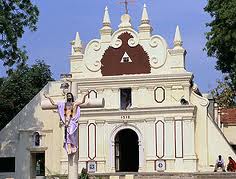 an unknown artist and brought here from Pondicherry in 1761. Famous people who married in St Mary’s include Lord Cornwallis, Elihu Yale (early Governor of Madras, who later founded Yale University in the US) and Robert Clive. Clive House, behind the church, is another reminder of the great empire-builder who started out as a humble clerk within this fort.The nearby Fort Museum, now housed in the Fort’s Exchange Office (1780-90), is open 9 am-5 pm but closed on Friday. The museum has 10 galleries with many exhibits telling the story of the East India Company’s activities in south India. The top floor has some good French porcelain, clocks and glass, and most interestingly, some rare 19th-century prints of Madras. The ground floor has East India Company memorabilia, including officers’ medals, tea-sets and cutlery. There is an old Arcot palanquin used by the pre-Raj Nawabs, a scale model of the fort, and a weird little iron cage in which a large, bearded officer spent a very long time after capture in combat. Admission is free.Just north of the fort is the magnificent High Court (1861), reputed to be the finest example of Indo-Saracenic architecture in India. It’s worth returning to later on, as you only get a fleeting glimpse from the bus, for a leisurely tour round its stately corridors, courts and staircases. There are several rare paintings here too, and a ‘lighthouse’ tower which was in use until 1977. You can climb to the top.Returning to the city centre, the tour makes a worthwhile visit to the
an unknown artist and brought here from Pondicherry in 1761. Famous people who married in St Mary’s include Lord Cornwallis, Elihu Yale (early Governor of Madras, who later founded Yale University in the US) and Robert Clive. Clive House, behind the church, is another reminder of the great empire-builder who started out as a humble clerk within this fort.The nearby Fort Museum, now housed in the Fort’s Exchange Office (1780-90), is open 9 am-5 pm but closed on Friday. The museum has 10 galleries with many exhibits telling the story of the East India Company’s activities in south India. The top floor has some good French porcelain, clocks and glass, and most interestingly, some rare 19th-century prints of Madras. The ground floor has East India Company memorabilia, including officers’ medals, tea-sets and cutlery. There is an old Arcot palanquin used by the pre-Raj Nawabs, a scale model of the fort, and a weird little iron cage in which a large, bearded officer spent a very long time after capture in combat. Admission is free.Just north of the fort is the magnificent High Court (1861), reputed to be the finest example of Indo-Saracenic architecture in India. It’s worth returning to later on, as you only get a fleeting glimpse from the bus, for a leisurely tour round its stately corridors, courts and staircases. There are several rare paintings here too, and a ‘lighthouse’ tower which was in use until 1977. You can climb to the top.Returning to the city centre, the tour makes a worthwhile visit to the 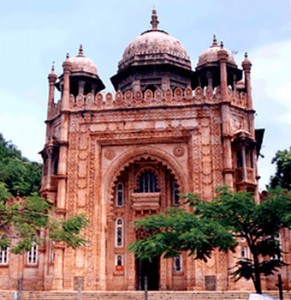 Government Museum in Pantheon Road. This is notable for its unequalled collection of fine bronzes, mainly from the early Pallava, Chalukya and Vijayanagar periods. One of the largest exhibits are the panels from the c. 200 BC Amaravati Stupa, said to have been erected over Gautama Buddha’s relics. The collection, which occupies a whole gallery, was discovered, and later excavated in 1816, by Colonel Colin Mackenzie who found the panels being used as building material. The museum is open 8 am-5 pm daily except Friday. So is the attached National Art Gallery, a fine Indo-Saracenic building. The gallery has a good collection of Mughal and Rajput miniatures, glass-paintings from Tanjore and some 11-12th century metalware.
Government Museum in Pantheon Road. This is notable for its unequalled collection of fine bronzes, mainly from the early Pallava, Chalukya and Vijayanagar periods. One of the largest exhibits are the panels from the c. 200 BC Amaravati Stupa, said to have been erected over Gautama Buddha’s relics. The collection, which occupies a whole gallery, was discovered, and later excavated in 1816, by Colonel Colin Mackenzie who found the panels being used as building material. The museum is open 8 am-5 pm daily except Friday. So is the attached National Art Gallery, a fine Indo-Saracenic building. The gallery has a good collection of Mughal and Rajput miniatures, glass-paintings from Tanjore and some 11-12th century metalware.
Down in Nungambakkam, the Hollywood of South India, and full of film studios, there’s an overlong stop at Valluvar Kottam, a memorial dedicated to the poet-saint Thiruvalluvar. Opened in 1976, its massive auditorium is one of Asia’s largest, containing 4000 seats, and is an important culture centre. 1330 of the poet’s verses from his classic Thirukkural are inscribed on polished granite. Outside, there’s a ‘temple chariot’ in stone, a vast rectangular terrace and extensive gardens.
Guindy Snake Park is 6 km (3 3/4 miles) further south, near Raj Bhavan (the Governor’s House). It’s a small, interesting reptiliurn of snakes, iguanas, crocodiles • and spiders. Here you can go chameleon-spotting, investigate the curious ‘Snake Worship Anthill’, and watch the hourly (from 10 am) demonstration of unfangedcobras being handled. You are also allowed to handle the snakes. Open 8.30 am-5.30 pm daily, admission Rs2. The Snake Park backs onto 300 acres of parkland supporting herds of blackbuck, many spotted deer or cheetal and monkeys. For a pleasant day here, return via urban train, or by No. 45 bus from Anna Square, city centre.
Off R.K. Mutt Rd, in the old Mylapore district, you’ll come next to Kapaleeshwara Temple.  Dedicated to Shiva, the temple’s legend (Parvati as a peacock, praying to Shiva for deliverance after some domestic transgression) is portrayed in sculpture within. The tall, 40-m gopuram tower, festooned with richly-coloured deities, is a distinctive feature of Dravidian temple architecture. You’ll see more of these throughout Tamil Nadu. Their principal purpose was to guard the inner shrine from attack, either spiritual or temporal. Considering how few south Indian temples suffered damage over the centuries, they seem to have been remarkably effective. Here, as with other ‘living’ temples in Tamil Nadu, non-Hindus are not allowed into the inner shrine.
Dedicated to Shiva, the temple’s legend (Parvati as a peacock, praying to Shiva for deliverance after some domestic transgression) is portrayed in sculpture within. The tall, 40-m gopuram tower, festooned with richly-coloured deities, is a distinctive feature of Dravidian temple architecture. You’ll see more of these throughout Tamil Nadu. Their principal purpose was to guard the inner shrine from attack, either spiritual or temporal. Considering how few south Indian temples suffered damage over the centuries, they seem to have been remarkably effective. Here, as with other ‘living’ temples in Tamil Nadu, non-Hindus are not allowed into the inner shrine.
After a brief visit to Elliot’s Beach, and just enough time for a paddle, the tour finishes off at San Thome Basilica, South Beach Rd. This is a gothic-style Catholic church said to house the remains of St Thomas, the ‘Apostle of India’, who died at nearby St Thomas Mount in AD 72. The original church of AD 1504 was replaced by the present structure in AD 1893.

